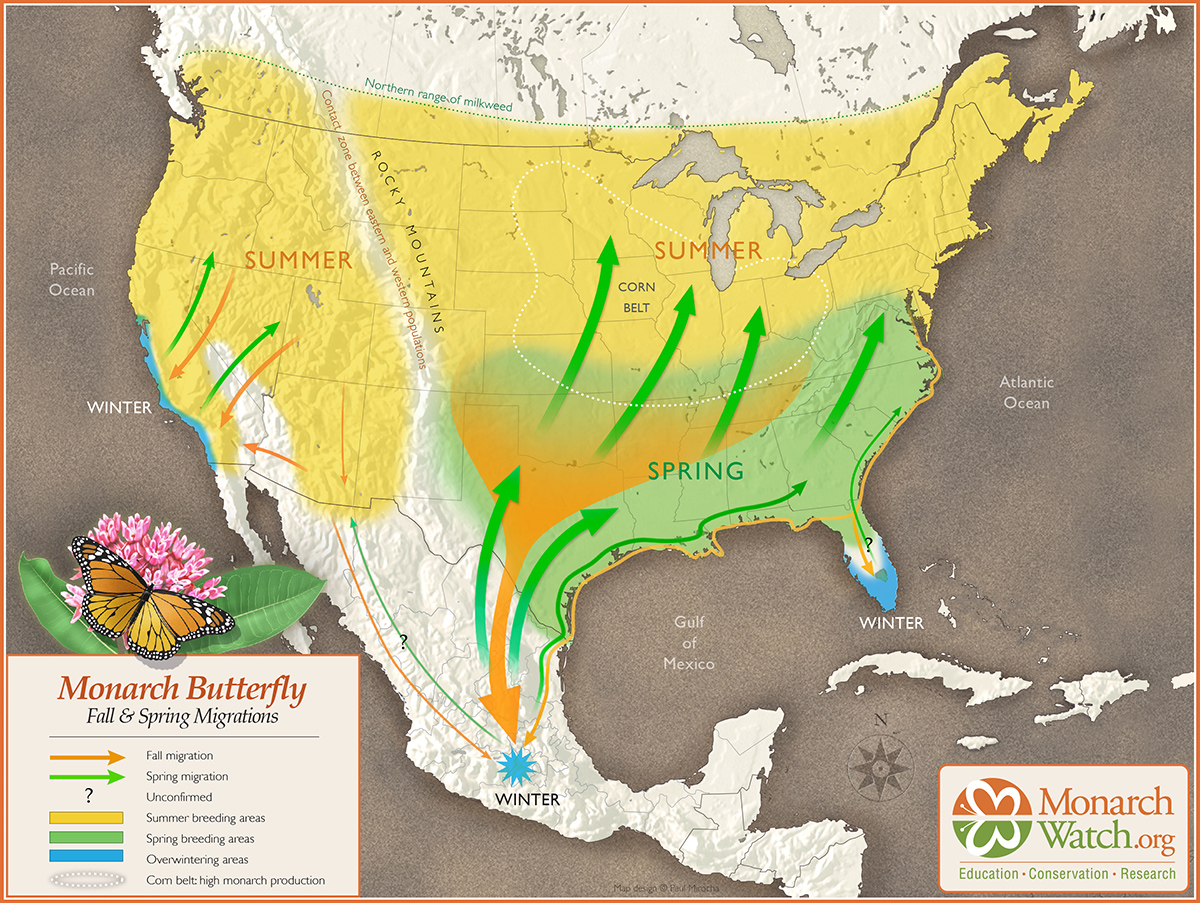
JOIN US TO HELP SAVE THE MONARCHS
Monarchs are Facing a Severe Population Decline
Famous for their seasonal migration, millions of monarchs used to travel almost 3,000 miles from the United States and Canada to Mexico for the winter. According to Xerces Society, an estimated 4.5 million flew in this migration in the 1980s. But today, their numbers in Mexico have drastically declined. For the Western Monarchs in California, it is even more dire. By 2020, the population had dropped to less than 0.01% of the historic size, with volunteers counting under 2,000 monarchs.
Causes of the massive monarch decline include habitat loss, the increasing use of pesticides, climate change, and extreme weather events. In particular for monarchs, the loss of milkweed has been devastating for the population because milkweed is the only plant that a monarch will lay its eggs on and is the only source of food for monarch caterpillars.
In July 2022…
…the IUCN added the migratory monarch butterfly (Danaus plexippus plexippus) to the IUCN Red List of Threatened SpeciesTM as Endangered, threatened by habitat destruction and climate change. Read the full press release here. Below are a couple of quick facts related to the news.
What is the IUCN?
The IUCN is an international organization that evaluates the populations of animal species all over the world. When you go to a zoo or aquarium, it is their threat assessments that a listed as they are internationally recognized for their expertise in this area.
Does this apply to all monarchs?
No. This specifically applies to the migrating population in the US and Canada. Nonmigrating populations of monarchs are not covered in this assessment. Populations of monarchs not covered by this: Florida, Central America and South America, Hawaii, and Australia.
Does this mean that monarchs are now a protected species?
No. In the United States, only the federal government can designate a species as receiving protections from the Endangered Species Act. The federal government has been watching the species for a number of years now and has not decided to list monarchs as an Endangered species.
Will monarchs go extinct?
Probably not, but it remains to be seen whether they will continue to migrate over the next 100 years.

Monarchs, Along With Other Butterflies and Pollinators, Are Essential To Our Ecosystem
Pollinators spread pollen from flower to flower, which is necessary for plants to become fertilized and produce fruits, seeds, and young plants. The National Pollinator Garden Network estimates that butterflies, bees, birds, bats, beetles, and other small mammals that pollinate plants are responsible for bringing us 1 out of every 3 bites of food we eat each day.
The Monarch is an Ambassador for All Pollinators
Because monarchs are so well known and their decline is easy to measure, they are leading indicators of what’s ahead for other pollinators. They need the same habitats as many other pollinators so if the population of monarchs is declining then it’s likely that many other pollinator species are already or will soon face similar declines.

HELP THE MONARCHS BY PLANTING A BUTTERFLY GARDEN
Increasing the number of host plants as well as nectar and pollen sources by providing more flowering plants and trees will help improve the health and numbers of monarchs and other pollinators. You can make a direct impact by planting a butterfly garden!
Guide to Planting a Butterfly Garden
THE BUTTERFLY WONDERLAND® FOUNDATION SUPPORTS THE “GOT MILKWEED?” INITIATIVE
The Butterfly Wonderland® Foundation is committed in its partnership with Butterfly Wonderland to provide an educational space with deep-rooted conservation initiatives. Our efforts to raise awareness about the rapid decline of the majestic monarch through our “Got Milkweed?” initiative is one of the many ways we seek to advance our mission and shared vision.
Please join our efforts in conservation awareness of the majestic monarch butterfly. Plant milkweed. Plant a butterfly garden. Get involved. Adopt-a-butterfly. Give to the Foundation.
All gifts support the mission and programs of the Butterfly Wonderland Foundation, a 501(c)(3) organization dedicated to conservation-based education and initiatives.
WANT MORE INFORMATION?
HERE ARE SOME ADDITIONAL RESOURCES
Central Arizona Butterfly Association (CAzBA)
cazba.org
Southwest Monarch Study
swmonarchs.org
Monarch Watch
monarchwatch.org
Journey North
journeynorth.com
The Lepidopterists Society
lepsoc.org
National Wildlife Federation
nwf.org
The Nature Conservancy
nature.org
North American Butterfly Association
naba.org
Monarch Larva Monitoring Project
mlmp.org
The Xerces Society
xerces.org
Pollination Partnership
pollination.org














